The Samsung 980 PRO PCIe 4.0 SSD Review: A Spirit of Hope
by Billy Tallis on September 22, 2020 11:20 AM ESTNote: All our previous testing has been on an Intel test bed. Because of the move to PCIe 4.0, we have upgraded to Ryzen. Devices tested under Ryzen in time for this review are identified in the charts.
Mixed Random Performance
Our test of mixed random reads and writes covers mixes varying from pure reads to pure writes at 10% increments. Each mix is tested for up to 1 minute or 32GB of data transferred. The test is conducted with a queue depth of 4, and is limited to a 64GB span of the drive. In between each mix, the drive is given idle time of up to one minute so that the overall duty cycle is 50%.
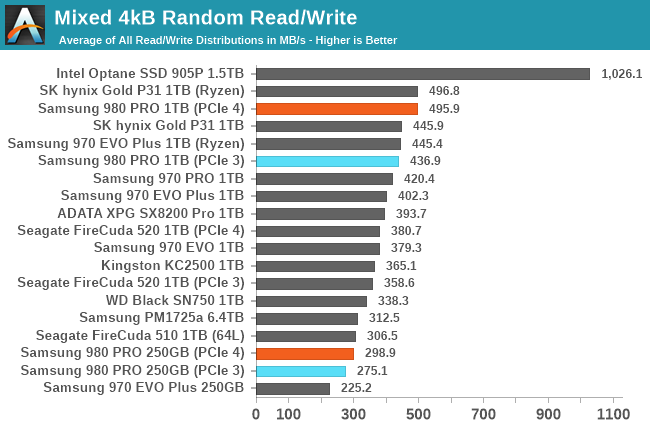
Since our mixed random IO test uses a moderate queue depth of 4, the PCIe Gen4 drives don't get much chance to flex their muscle. The overall scores are still generally bound by NAND flash latency, which doesn't vary too widely between current generation drives. There's also a small performance boost when running this test on our newer, faster Ryzen testbed. The Samsung 980 PRO is clearly an improvement over its predecessors, but is merely tied for first place among flash-based drives with the SK hynix Gold P31.
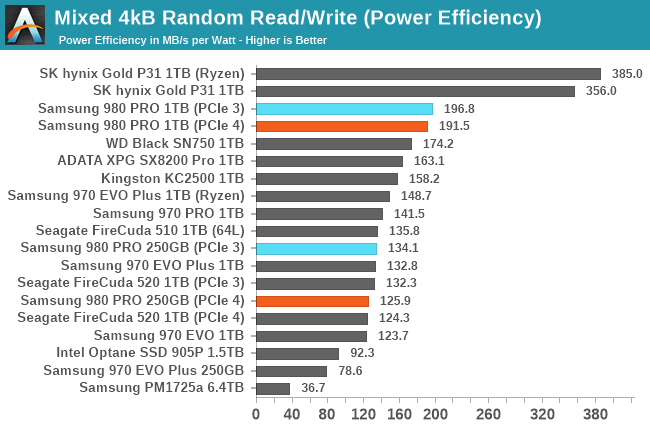 |
|||||||||
| Power Efficiency in MB/s/W | Average Power in W | ||||||||
Both capacities of the 980 PRO turn in good efficiency scores for the mixed random IO test, substantially improving on Samsung's previously mediocre standing. The 1TB 980 PRO's efficiency is second only to the SK hynix Gold P31. The 980 PROs are a bit more efficient running at PCIe Gen3 speeds than on the Gen4 platform, despite the ~10% performance boost on the faster system.
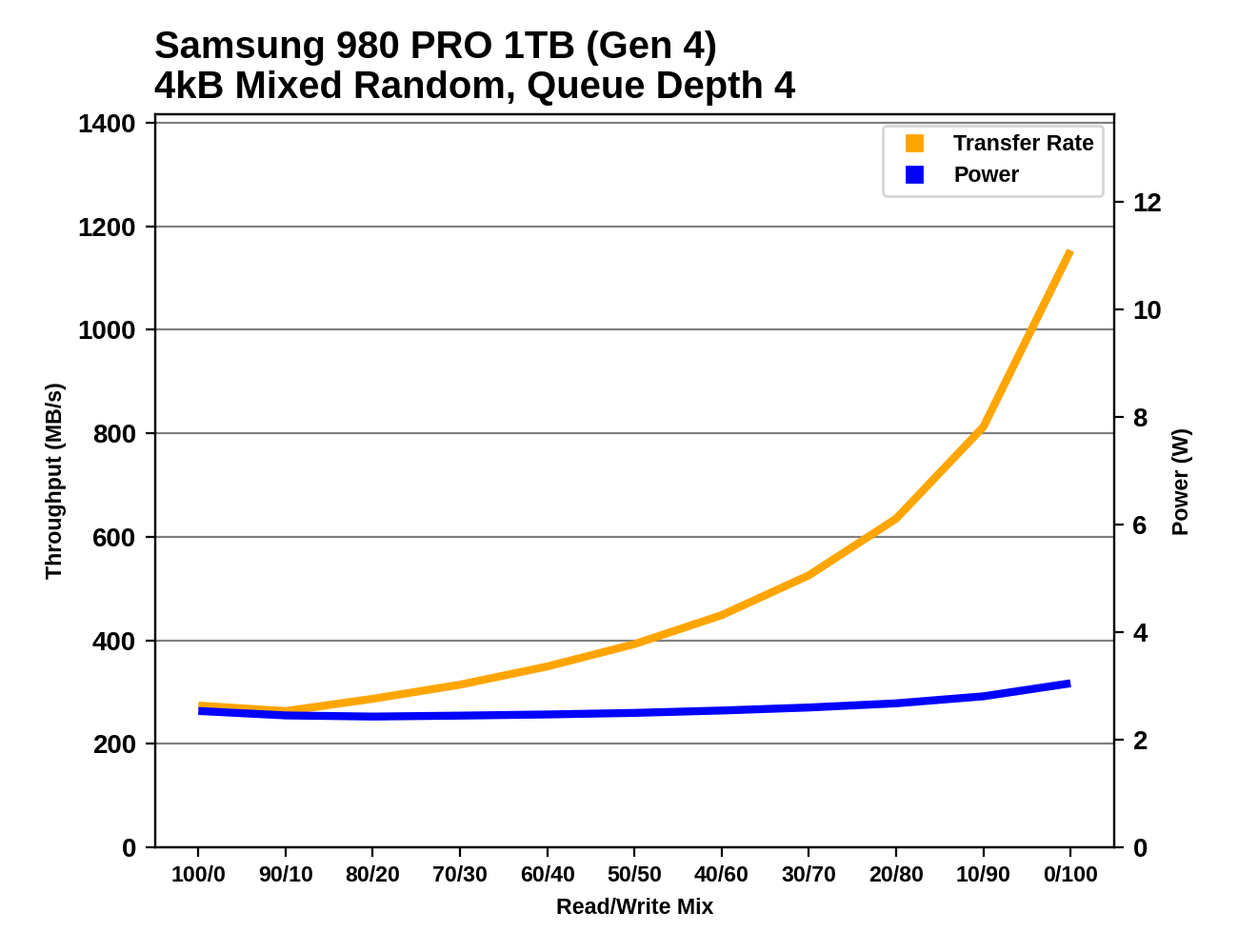 |
|||||||||
There are no real surprises in the performance profiles of the 980 PROs. Both capacities show the same general behavior as earlier Samsung drives, albeit with small improvements to performance and power consumption across the board.
Mixed Sequential Performance
Our test of mixed sequential reads and writes differs from the mixed random I/O test by performing 128kB sequential accesses rather than 4kB accesses at random locations, and the sequential test is conducted at queue depth 1. The range of mixes tested is the same, and the timing and limits on data transfers are also the same as above.
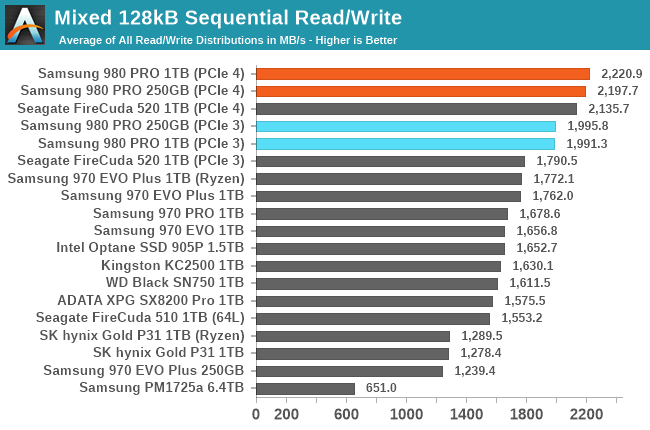
The Samsung 980 PROs take the top spots for our mixed sequential IO test, with even the 250GB 980 PRO edging out the 1TB Seagate FireCuda 520. Even when limited to PCIe Gen3, the 980s are a clear step up in performance from eariler high-end drives. The improvement for the 250GB model is the most impressive, since the 250GB 970 EVO Plus is significantly slower than most of the 1TB drives.
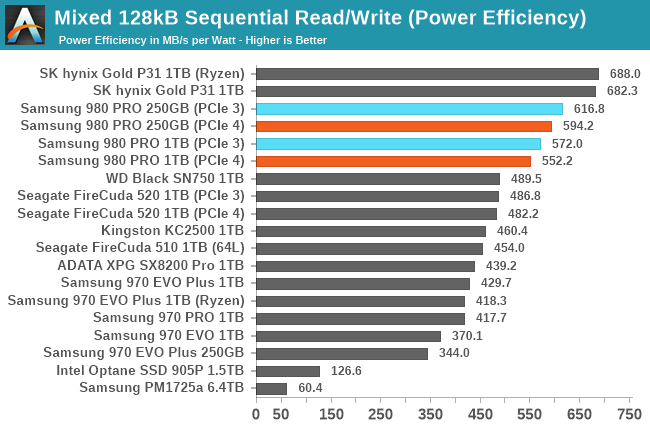 |
|||||||||
| Power Efficiency in MB/s/W | Average Power in W | ||||||||
The 980 PROs turn in more good power efficiency numbers that place them clearly ahead of everything other than the SK hynix Gold P31. And this time, the P31's efficiency lead relatively small at no more than about 25%.
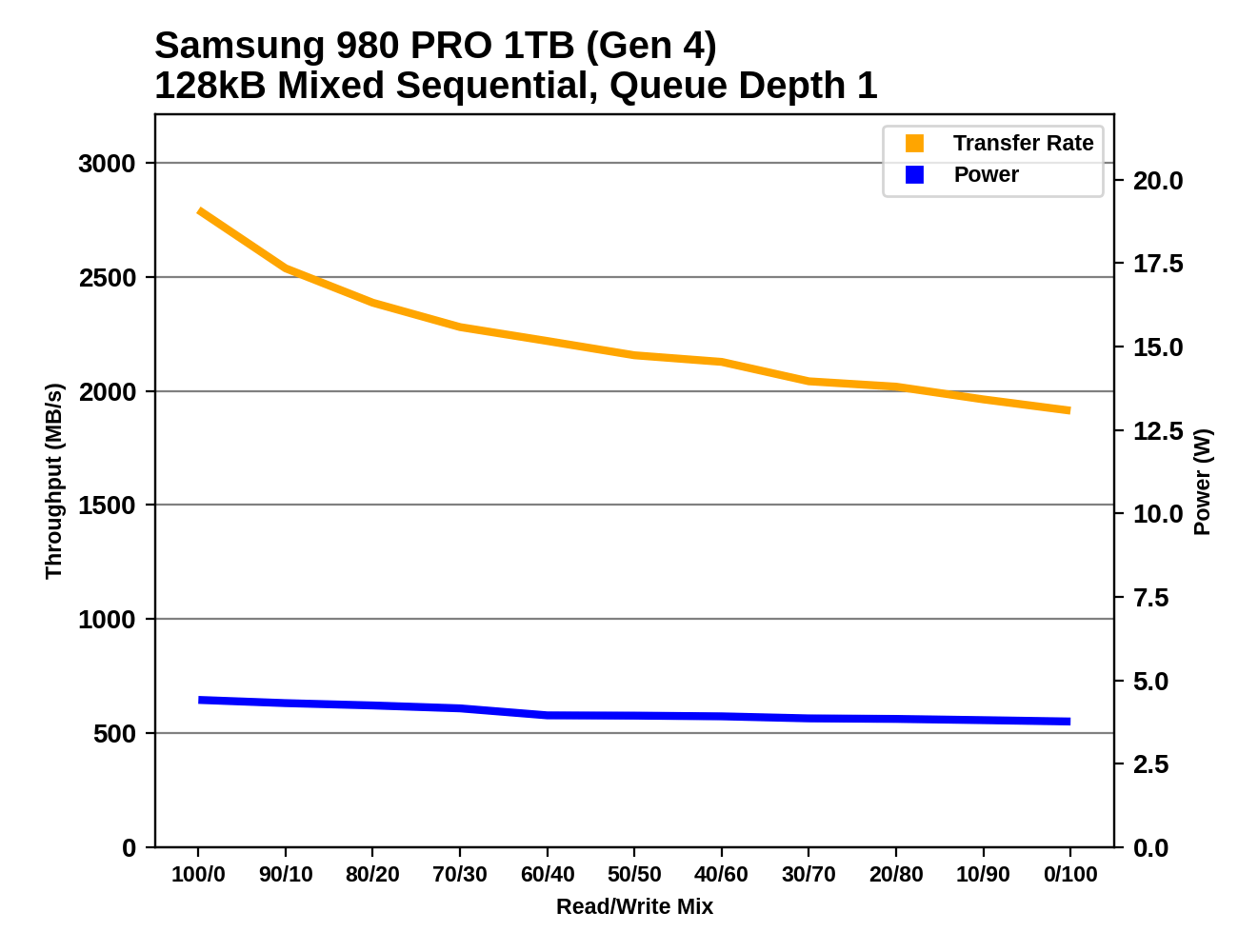 |
|||||||||
The 980 PROs show a drastically different performance profile compared to earlier Samsung drives. The 970s tend to bottom out during the write-heavy half of the test and recover some performance toward the end. Now with the 980 PRO, performance in the write-heavy half doesn't drop precipitously, so we see a steady decline that most closely resembles how the Intel Optane SSD handles this test










137 Comments
View All Comments
jeremyshaw - Tuesday, September 22, 2020 - link
Given how fast the TLC was when the SLC cache was exhausted (and was undoubtedly working on flushing the SLC cache into TLC), I wonder how much faster the native TLC mode of the SSD could be?Billy Tallis - Tuesday, September 22, 2020 - link
Their ISSCC 2019 presentation about the 512Gbit 128L die (which will be used in the 2TB 980 PRO) claims a write speed of 82MB/s per die. The 1TB 980 PRO is using a total of 32 of the 256Gbit dies, and if it's the same speed then that would work out to 2624 MB/s. So that suggests the total drive fill process is barely slowed down at all by the SLC caching dance, and a datacenter drive using this NAND and controller could hit almost twice the write throughput the current 960GB 983 DCT is rated for.System75 - Wednesday, September 23, 2020 - link
Why don't you test a fully filled SSD performance anymore like you used to in AnandTech Storage Bench - Heavy? An empty 980 pro drive performance is not what its target consumer wants to know.alyarb - Tuesday, September 22, 2020 - link
thanks for the memories Samsung, but I'm outnandnandnand - Tuesday, September 22, 2020 - link
Is the Spirit of Hope dead?Hyoyeon - Tuesday, September 22, 2020 - link
That SK Hynix P31 could become my new favorite drive.Hifihedgehog - Tuesday, September 22, 2020 - link
Not quite. The P31 is an amazing value, but I have yet to find a lower latency drive than a Samsung. The P31 does nip at the heels and even surprises in some tests, but it still falls massively short in many latency-sensitive situations where it is easily outclassed by the 970 EVO Plus and above. You get what you pay for.https://www.storagereview.com/review/sk-hynix-gold...
https://www.storagereview.com/review/sk-hynix-gold...
lmcd - Tuesday, September 22, 2020 - link
For laptop usage that latency is not even close to worth it. I'm optimistic the upgrade from a 970 EVO (don't worry, it's primarily for a capacity upgrade) will help my inefficient Ryzen 2700U hold on a bit longer when off the charger.MikeMurphy - Tuesday, September 22, 2020 - link
The P31 performs admirably and does so while consuming very little power and producing very little heat. It doesn't trounce the Samsung drives in every metric but at that price and power budget it doesn't have to.Samus - Wednesday, September 23, 2020 - link
If Hynix wanted to crank up the heat and power consumption, there is nothing stopping them operating the controller at a higher frequency to reduce the latency caused by processing overhead.But they realize there is no need for this at the moment as they have a product that is class-leading in a class it doesn't even compete in.